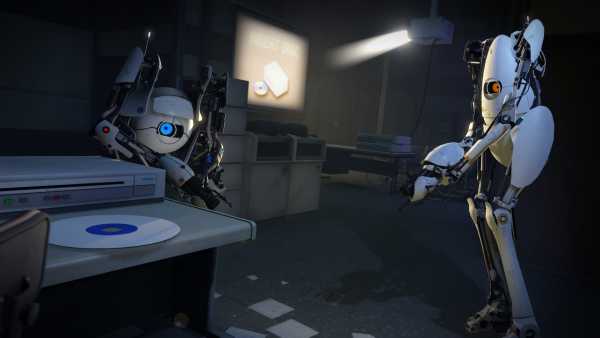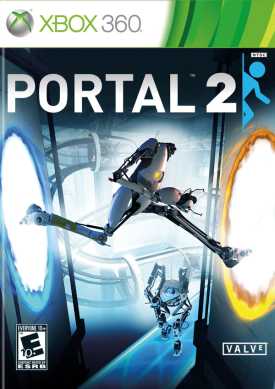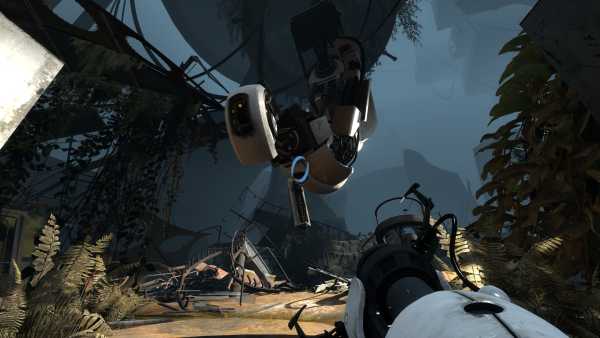
 BUY IT FROM AMAZON: RIGHT HERE!
BUY IT FROM AMAZON: RIGHT HERE!
PLATFORM: Xbox 360 (reviewed), PS3, PC
ESRB RATING: E10+
DEVELOPER: Valve Corporation
PUBLISHER: EA/ Valve Corporation
The best puzzle games haunt you.
Think of the first time you played Tetris all night and tried to sleep, only to keep trying to make lines on the back of your eyelids. Tetris Attack, Puzzle Quest, Columns, all games that get burnt into your memory like on a crappy plasma tv, making you see patterns in the world and try to keep matching up pieces long after you’ve finished playing.
Portal managed to combine a clever puzzler with a first person shooter, and it was the highlight of Valve’s Orange Box when it was released, Team Fortress 2 (fun though it is) be damned. Now the sequel’s here, promising not only a full retail experience but also co-op gameplay.
Walking around Manhattan after a five hour session with the game, it was hard not to keep looking for places I could shoot a portal. Throw a portal on that billboard, jump into another on the ground and I’d be able to fly across the street with no problem. Why, look at all those surfaces that seem perfect for a portal! I rubbed my eyes and continued on my way, wondering when I’d next get a chance to play.
Portal 2 is as good as you hoped, a fantastic game made even better with a friend.
THE PITCH
You play as Chell, the human guinea pig from the first game. She’s still at the mercy of Aperture Laboratories, whose seemingly pointless and dangerous science experiments nearly killed her, escaping only to become stuck in stasis and left there for a few hundred years. You’re woken up and saved by an AI core named Wheatley (voiced by Stephen Merchant of The Office and Extras fame), who has found you alive among the numerous test subjects at the facility. Chell’s the only survivor. You find out that the place is falling apart, but not before accidentally rebooting GLaDOS (once again hysterically voiced by Ellen McLain), the insane test-hungry AI that tried to kill you last time.

CHUDTIP- It might be a good idea to run. You monster.
In the last game she at least attempted to hide her murderous intents for a bit but in this one everyone’s trying to kill you, sometimes quite actively. As you try to escape you’ll also find an older section of Aperture where you’re forced to contend with the recorded voice of Aperture Laboratories CEO Cave Johnson, voiced by one J.K. Simmons.
THE PLAY
The game plays exactly the same as the first. You’re given a portal gun that can shoot two different colored portals, blue and orange. Shoot both on surfaces and you’ll be able to walk, jump, and throw objects through, easily bridging massive gaps and leaping across distances by defying the laws of physics.
The controls are simple- the left trigger controls the blue portal, the right the orange. There’s a jump button and a crouch button, and the one new addition is a zoom button, which allows you to see portal-ready surfaces across the much-expanded game world.
Basic gameplay remains the same, as it’s really just puzzle after puzzle, but it’s not as segmented as in the first game. Sure, you’ll do plenty of numbered experiments where a crazed robot is throwing increasingly dangerous puzzles at you, but you’ll also see plenty of behind the scenes areas which offer up a bit more free-form exploration.
Along with the portal gun there are some new goodies to play with, most stemming from various colors of gel that can be splashed around the environment whenever you find one of their pipes. Blue makes you bounce and jump incredible distances, orange lets you slide to supersonic speeds, and white lets you place portals on walls that wouldn’t let you previously. All of them have to be used creatively to get to the exits, sometimes all at once.

CHUDTIP- Messing with your friends is not only possible, it's encouraged.
There are a couple other new gadgets like exploding crates, crates that redirect lasers and light bridges, all presented to you staggered throughout the game to keep things interesting. As if the voice acting and story won’t keep you playing anyway.
The co-op campaign is a revelation, though. With a friend there are four portals to play with and so many new ways to utilize them and navigate the world. This is a fully featured campaign, too, with brand new characters in a standalone story. You play as one of two robots that GLaDOS is much more likely to just destroy for no reason, because you can be rebuilt. They have much more personality than Chell and even come with little gestures like high fives and dances that you can do to communicate non-verbally. The campaign is much more fun than the single player and offers up a lot of challenges along the way, the perfect thing to jump into after finishing the single player and getting up to speed on how everything works.
THE PRESENTATION
After centuries of neglect Aperture is starting to fall apart, and the world isn’t the white, sanitized vision it used to be. Chunks of the walls are falling down, panels are sparking and jumping in death throes, and whole test areas are being ripped apart and crushed together with others to form new ones in front of your eyes. The lighting and textures are pretty stunning and the Source Engine has never looked better, but it’s still showing its age a bit.
I probably don’t have to tell you how amazing the voice acting is, what with those three actors contributing. Yes, it’s another in a long line of games where disembodied voices talk your ear off about what you should be doing but when it’s this gut-bustingly hysterical you won’t mind. There’s a moment where J.K. Simmons goes on a rant about life giving you lemonades that almost gave me a hernia, I was laughing so hard.
Those hoping for another song at the end on par with Still Alive? Well, nothing could compete with the joyous surprise of that, but you’ve still got plenty to look forward to…
THE REPLAY
8-10 hours to complete the single player campaign means that it’s a nice chunk of time, although due to the more talky and narrative-heavy nature of the game it’s less likely that you’ll want to try and go back to beat the puzzles a second time, although there are tons of achievements and secrets to find along the way. The odd absence of challenge levels that were in the first game might drag you down, but fortunately when you’re done with single player there’s a co-op campaign that can take you a good 4 hours to complete.
THE VERDICT
As much as I loved this game, I’m still not convinced that a long-form Portal was the best idea. It’s only at its best as a puzzle game, and while the story is welcome the portions between puzzles can sometimes feel like filler. Valve certainly helped pioneered narrative in first person shooters with Half Life, but the style has been getting increasingly tedious. Like nearly every other first person title from the last decade Portal 2 has scripted events happen around you. It used to be exciting until you realized that it doesn’t make for any real interaction with the story- it’s a theme park ride. Of course, one could argue that it makes narrative sense to be constantly told where to go and what to do but it’s irritating to play a game that just shuttles you along, especially one that’s otherwise so innovative. The best of the puzzles just leave you on your own to figure out what to do, but unfortunately none of them are terrible hard, and you won’t get stumped for more than a few minutes on any of them. In fact, I’d say that the game is much easier than the first, and the only real challenge comes during some of the co-op missions.

CHUDTIP- Do gestures in front of GLaDOS' cameras to really piss her off.
Of course, all of these issues with the presentation are nullified thanks to an incredibly funny script, made better by the fantastic voice actors they’ve amassed here. It’s undeniable how much sheer fun this game is and you’ll love finding out more about the history of Aperture Laboratories, even if it does take us to an often-used period for videogames- the 1950s and 60s. (See Bioshock, Singularity, Fallout, etc.)
Some extra modes (time trials and the like) are missed because once you’ve beaten the puzzles here there’s nothing else to do or try. But it’s one helluva ride. Good luck getting it out of your head.
Rating: 




Out of a Possible 5 Stars